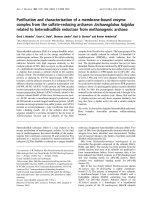Báo cáo khoa học: " Intrathecal colistin for treatment of Pseudomonas aeruginosa ventriculitis: report of a case with successful outcome" ppsx
Bạn đang xem bản rút gọn của tài liệu. Xem và tải ngay bản đầy đủ của tài liệu tại đây (24.56 KB, 1 trang )
Page 1 of 1
(page number not for citation purposes)
Available online />Infection of the ventricular cavity and of the ependymal lining
is most often iatrogenic in origin, being a complication of a
shunting procedure or of intrathecal chemotherapy. The
emergence of multidrug-resistant Gram-negative bacteria and
the lack of new antibiotics to combat them have led to the
revival of polymyxins, an old class of cationic, cyclic
polypeptide antibiotics.
Polymyxin B and polymyxin E (colistin) are the two polymyxins
used in clinical practice. Colistin is a polymyxin-type anti-
biotic, disrupting the structure of Gram-negative organisms’
cell membranes, rarely used parenterally because it has
nephrotoxic side effects. The polymyxins are active against
selected Gram-negative bacteria, including Acinetobacter
species, Pseudomonas aeruginosa, Klebsiella species and
Enterobacter species [1]. We report a case of multidrug-
resistant P. aeruginosa ventriculitis treated successfully with
intrathecal colistin.
A 16-year-old boy who had a car accident required
hospitalization and underwent multiple surgeries, including
decompressive craniectomy and placement of ventriculo-
peritoneal and ventriculoatrial shunts. The ventriculoatrial
shunt subsequently became colonized with P. aeruginosa
and was removed, and was then replaced with an external
ventricular drainage catheter. Cerebrospinal fluid cultures
demonstrated multiresistant P. aeruginosa. Intravenous
amikacin was initiated initially but there was no change in the
patient’s clinical situation. Therapy was then changed to
intrathecal colistin 5 mg/day via the external ventricular
drainage catheter, and the cerebrospinal fluid white blood
cell counts and cerebrospinal fluid cultures were followed to
assess efficacy. The patient’s response to therapy was
observed with a decrease in the cerebrospinal fluid white
blood cell count in the following days and with subsequent
sterilization of cultures. His clinical situation became well and
weaning from the mechanical ventilation was initiated.
There are few case reports about the treatment of ventriculitis
with intrathecal use of colistin. In a case report, meningitis
caused by a multiresistant Gram-negative rod was success-
fully treated with intrathecal colistin 5 mg/day on day 1 and
with 10 mg intrathecal colistin per 24 hours for 21 days there-
after [2].
We used intrathecal colistin 5 mg/day for 21 days for the
treatment of multidrug-resistant P. aeruginosa and succeeded
without any side effects. Our experience shows that
intrathecal colistin is a safe and curative treatment drug for
multidrug-resistant P. aeruginosa ventriculitis.
Competing interests
The author(s) declare that they have no competing interests.
References
1. Falagas ME, Kasiakou SKN: Colistin: the revival of polymyxins
for the management of multidrug-resistant gram-negative
bacterial infections. Clin Infect Dis 2005, 40:1333-1341.
2. Vasen W: Intrathecal use of colistin. J Clin Microbiol 2000, 38:
3523.
Letter
Intrathecal colistin for treatment of
Pseudomonas aeruginosa
ventriculitis: report of a case with successful outcome
Rezzan Yagmur
1
and Figen Esen
2
1
Hisar Intercontinental Hospital, Anesthesiology and ICU, Istanbul, Turkey
2
Istanbul University Medical Faculty Department of Anesthesiology and ICU, Istanbul, Turkey
Corresponding author: Rezzan Yagmur,
Published: 28 December 2006 Critical Care 2006, 10:428 (doi:10.1186/cc5088)
This article is online at />© 2006 BioMed Central Ltd









